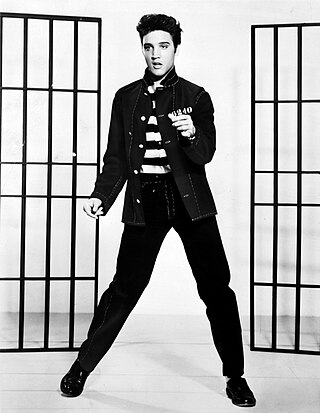
Elvis Aaron Presley, often referred to mononymously as Elvis, was an American singer and actor. Dubbed the "King of Rock and Roll", he is regarded as one of the most significant cultural figures of the 20th century. His energized interpretations of songs and sexually provocative performance style, combined with a singularly potent mix of influences across color lines during a transformative era in race relations, led him to both great success and initial controversy.

Graceland is a mansion on a 13.8-acre (5.6-hectare) estate in Memphis, Tennessee, United States, once owned by the rock and roll singer Elvis Presley. Presley is buried there, as are his parents, paternal grandmother, grandson and daughter. The property also contains a memorial to Presley's stillborn twin brother.

"Heartbreak Hotel" is a song recorded by American singer Elvis Presley. It was released as a single on January 27, 1956, Presley's first on his new record label RCA Victor. It was written by Mae Boren Axton and Tommy Durden, with credit being given also to Presley.

Winfield Scott Moore III was an American guitarist who formed The Blue Moon Boys in 1954, Elvis Presley's backing band. He was studio and touring guitarist for Presley between 1954 and 1968.

"Hound Dog" is a twelve-bar blues song written by Jerry Leiber and Mike Stoller. Recorded originally by Big Mama Thornton on August 13, 1952, in Los Angeles and released by Peacock Records in late February 1953, "Hound Dog" was Thornton's only hit record, selling over 500,000 copies, spending 14 weeks in the R&B charts, including seven weeks at number one. Thornton's recording of "Hound Dog" is listed as one of the Rock and Roll Hall of Fame's "500 Songs That Shaped Rock and Roll", and was inducted into the Grammy Hall of Fame in February 2013.

The Sun Sessions is a compilation album by American singer Elvis Presley, containing songs he recorded at Sun Studios in 1954 and 1955. It was issued by RCA Records in 1976, and had been issued and charted as The Sun Collection in the UK the previous year. It features liner notes by Roy Carr of the New Musical Express. The Sun Sessions features most of the tracks Elvis recorded at Sun studio and were produced by Sam Phillips, the head of Sun Studios. Elvis began his singing career with Sun Records label in Memphis. The album reached number two on the Billboard Country Albums and number 1 on the Cashbox Country Albums charts.
Charles Franklin Hodge, better known as Charlie Hodge, was an American singer, vocal coach and musician who was a confidant and best friend of Elvis Presley, and lived at Graceland.

Elvis Is Back! is the fourth studio album by American rock and roll singer Elvis Presley, released on April 8, 1960 by RCA Victor. It was Presley's first album released in stereo. Recorded over two sessions in March and April, the album marked Presley's return to recording after his discharge from the U.S. Army. It was Presley's first album of new material since Elvis' Christmas Album was issued in 1957.
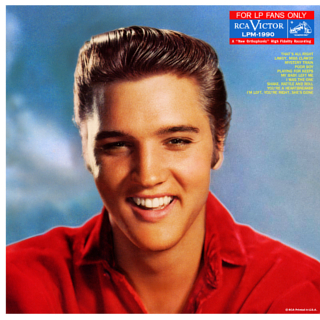
For LP Fans Only is a compilation album by American singer and musician Elvis Presley, released on February 6, 1959 by RCA Victor. It compiled previously released material from an August 1956 recording session at 20th Century Fox Stage One, a September 1956 session at Radio Recorders in Hollywood, sessions on January 10 and 11 at the RCA Victor Studios in Nashville, two more at the RCA Victor Studios in New York, and multiple sessions at Sun Studio. The album reached number 19 on the Billboard Top Pop Albums chart.

Elvis: A Legendary Performer Volume 1 is a compilation album by American singer and musician Elvis Presley issued in 1974 by RCA Records. It features 14 tracks, which includes twelve songs and two interviews with Presley. It was certified Gold on January 8, 1975, Platinum and 2× Platinum on July 15, 1999, and 3× Platinum, by the Recording Industry Association of America (RIAA) on March 8, 2018.

The TCB Band is a group of musicians who formed the rhythm section of Elvis Presley’s band from August 1969 until his death in 1977.. The initials TCB stand for Taking Care of Business, a personal motto Presley adopted in the early 1970s. Although personnel changed over the years, the original members were James Burton, Jerry Scheff (bass), John Wilkinson, Larry Muhoberac (keyboards) and Ron Tutt (drums). They first appeared live at Presley’s first Las Vegas performance at what was then known as the International Hotel on July 31, 1969.
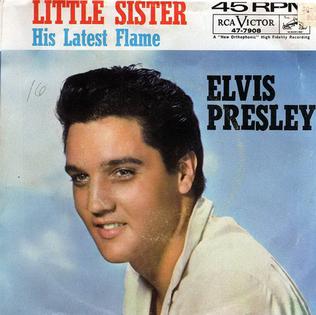
"Little Sister" is a rock and roll song written by Doc Pomus and Mort Shuman. It was originally released as a single in 1961 by American singer Elvis Presley, who enjoyed a No. 5 hit with it on the Billboard Hot 100. The single also reached No. 1 in the UK Singles Chart. Lead guitar was played by Hank Garland and the rhythm guitar was played by Scotty Moore with backing vocals by the Jordanaires featuring the distinctive bass voice of Ray Walker.
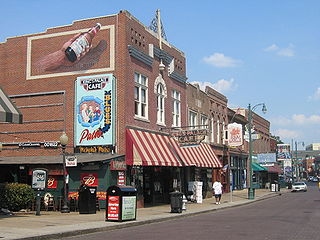
Tourism in Memphis includes the points of interest in Memphis, Tennessee such as museums, fine art galleries, and parks, as well as Graceland the Beale Street entertainment district, and sporting events.

Elvis Presley's iconic Pink Cadillac was a 1955 Cadillac Fleetwood Sixty Special. It set style for the era, was sung about in popular culture, and was copied by others around the world.

My Farewell to Elvis is the 27th studio album by American country singer Merle Haggard, released in 1977 and his second release for MCA Records. It reached Number 6 on the Country album chart. The single "From Graceland to the Promised Land" reached number 4 on the Billboard Country Singles chart. The album is a tribute to the music of Elvis Presley, who died on August 16, 1977. He is backed by Roy Nichols, Ronnie Reno, and Mark Yeary of The Strangers.

Fun in Acapulco is the seventh soundtrack album by American singer and musician Elvis Presley, released on RCA Victor Records in mono and stereo, LPM/LSP 2756, in December 1963. It is the soundtrack to the 1963 film of the same name starring Presley. Recording sessions took place at Radio Recorders in Hollywood on January 22 and 23 and February 27, 1963; and at RCA Studio B in Nashville, Tennessee, on May 26 and 28, 1963. It peaked at number three on the Billboard Top Pop Albums chart.
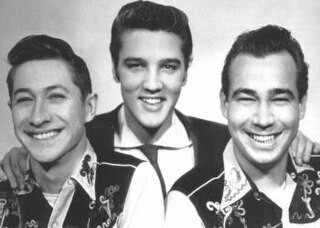
The Blue Moon Boys were an American rock and roll band that was formed by Elvis Presley, lead guitarist Scotty Moore and double bass player Bill Black. The group members were introduced by Sun Studio owner Sam Phillips in 1954, except for D.J. Fontana, who joined the group during a Louisiana Hayride tour in 1955. The Blue Moon Boys were inducted into the Musicians Hall of Fame and Museum in 2007. The band was named after Bill Monroe's song "Blue Moon of Kentucky".
The EchoSonic is a guitar amplifier made by Ray Butts. It was the first portable guitar amplifier with a built-in tape echo effect, and it allowed guitar players to use slapback echo, which dominated 1950s rock and roll guitar playing, on stage. He built the first one in 1953 and sold the second one to Chet Atkins in 1954. He built fewer than seventy of those amplifiers; one of them was bought by Sam Phillips and then used by Scotty Moore on every recording he made with Elvis Presley, from the 1955 hit song "Mystery Train" to the 1968 TV program Comeback Special. Deke Dickerson called the amplifier the Holy Grail of rockabilly music.

Elvis Presley House is a one-story ranch style house in a residential neighborhood in Memphis, Tennessee. Singer Elvis Presley lived here with his parents between March 1956 and March 1957, before moving to Graceland.

The Gibson ES-295 (1952-1959) is a hollow body guitar which was built by the Gibson Guitar Company. The ES-295 was introduced in May 1952 as a fancier version of the ES-175. The 295 had the same measurements as the ES-175, but it came in Gold finish and featured a combination trapeze bridge/tailpiece.






















